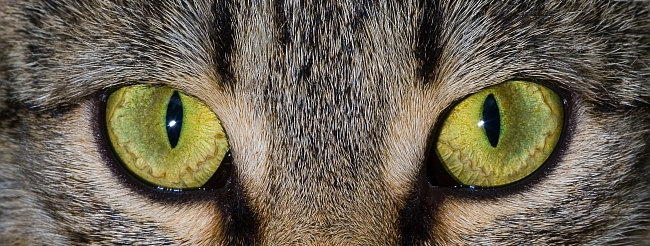
Cat eyes are undoubtedly mysterious . They glow eerily in headlights, and are reputedly able to see in the dark. Cats are known for their stealthy hunting skills in the most unlikely of settings and conditions. However, while cats are indeed able to see things the human eye cannot detect, their eyes lack certain abilities the human eye possesses.
Color & Light Perception
Contrary to popular belief, cats are not able to see in the complete absence of light. They can indeed glide effortlessly through challenging areas, but this is largely because of the sensory power of their whiskers which provide the ability to navigate in dark surroundings. However, cat eyes are powerful tools, requiring far less light (one sixth of the light than we require) to see affectively in dark or dimly lit areas.
Cat eyes posses more rods than human eyes do, allowing them to absorb and detect more light than we can. Felines also have a further layer of tissue toward the back of the eyes called the tapetum lucidum. The tapetum lucidum can reflect 130 times more than the human eyes, and is the reason why cat eyes appear to glow when a light shines directly on them. The light reflects inside the eye, giving the feline the ability to see better in the darkness.
However, the realm of color that cats are able to perceive is much more limited than humans. They have fewer cones than we, and many scientists believe that cats struggle to detect all shades of red and green. If this notion is true, cats perceive far less vibrancy than humans, even though they are able to distinguish shapes more clearly in the dark.
Detail, Distance & Proximity
Feline vision also skips over detailing like the veins in a leaf, or lettering on a page; they are also severely impaired when it comes to seeing objects up close. While cats may not be able to identify tiny markings or details in an object, they are superior at detecting even the tiniest motion or change of shapes over a broad area. Cats excel with binocular (long distance) and peripheral (side) vision more than they do with the nearsighted vision. Compared to humans that have 120 degrees of binocular and 90 degrees of peripheral vision; cats possess 130 degrees (binocular) and 120 degrees (peripheral).
One of the reasons why scientists believe that cats are farsighted is because their lenses don’t change shape to focus on an item in closer proximity. Cat vision is at its sharpest when the object he is looking at is several feet away.
The rest of the cat’s anatomy would support the conjecture that his nearsighted vision is limited. The short whiskers on the chin, face and forepaws are sensory “sight” signalers that are necessary for hunting in close proximity when a cat’s eyes are not their strongest. Without these kinds of sensors, the cat would not be able to see clearly enough to go in accurately for the kill.
The Pupil
Cat eyes come in different shapes, and can be slanted, almond and round. But it is their pupils which are far more intriguing than the eye shape. Felines engage differently with light because of their swift ability to avoid or absorb it sufficiently for their needs. The cat’s pupil is shaped like a slit that can shrink to the size of a sliver (thereby limiting the intake of light, and not being blinded by the sun or sudden increase of brightness), or by expanding into a dilated pupil that can take in what little light there may be available to see clearly when it is dark. The eyes are of such importance to their very survival, that cats anatomically have further protective lids than humans. Cats also have a third eyelid that is called the nictitating membrane, which sustains the moisture in a cat’s eye, and helps act as a shield when the eyes needs special protection from dust or dryness. Though cats are far from supernaturally gifted, the visual ability of cats is certainly a fascinating study.

